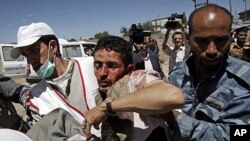Security forces loyal to embattled Yemeni President Ali Abdullah Saleh fired at protesters and armed dissidents in the capital Sana'a Saturday, killing at least 12 people and wounding dozens. Earlier, an airstrike in southeastern Yemen's Shabwa province killed at least nine people, including a number of local al-Qaida figures.
Yemeni government security forces fired teargas and live rounds of ammunition into crowds of opposition supporters Saturday, causing numerous casualties. Witnesses say the government forces were attempting to stop the protesters, who were advancing towards their positions.
Arab satellite channels showed wounded young men in obvious pain as doctors and medics applied antiseptics to their wounds. Dozens of casualties were lined up on the floor of one local hospital.
The opposition march began at Sana'a University, where protesters shouted slogans against the government and carried banners calling for the resignation of embattled President Ali Abdullah Saleh.
Shooting and scuffles broke out after demonstrators tried to cross into territory held by forces loyal to President Saleh along Zubeiri Street. A dissident army unit, loyal to defected army commander Ali Mohsen al-Ahmar controls the square and surrounding district where protesters are camped out.
Deputy Information Minister Abdou Janadi deplored the casualties, but insisted that it was the opposition that provoked the clashes. He says the casualties are unfortunate, but accuses the opposition of using the protesters as a human shield and dispatching them in the direction of loyalist forces for a confrontation.
Stephen Steinbeiser, who heads the American Center for Yemeni Studies in Sana'a, says the capital has increasingly been divided up into rival centers of power that sometimes come into conflict.
"The situation feels like a low-level civil war, and there are parts of the city downtown where we are that you just can't really go into," Steinbeiser noted. "Some of these areas have been blocked off for months and it does look like a war zone. It looks like kind of the early days of the civil war in Beirut. On the one side you have the burned out buildings and cars, on the other side you have the pocked-marked buildings. It's not completely destroyed, but the soldiers are taking positions on the street corners..."
Steinbeiser argues that the "longer the (chaos) continues, the worse the situation becomes... and the less likely it is for any kind of peaceful resolution." He also notes that the rest of Yemen is in a holding pattern, "waiting to see who wins in the capital."
A Yemeni goverment official said that overnight several suspected U.S. air strikes targeted al-Qaida positions in Shabwa province killing several al-Qaida leaders including the media chief for al-Qaida's Yemen branch and a son of slain U.S. born cleric Anwar al-Awlaki.












